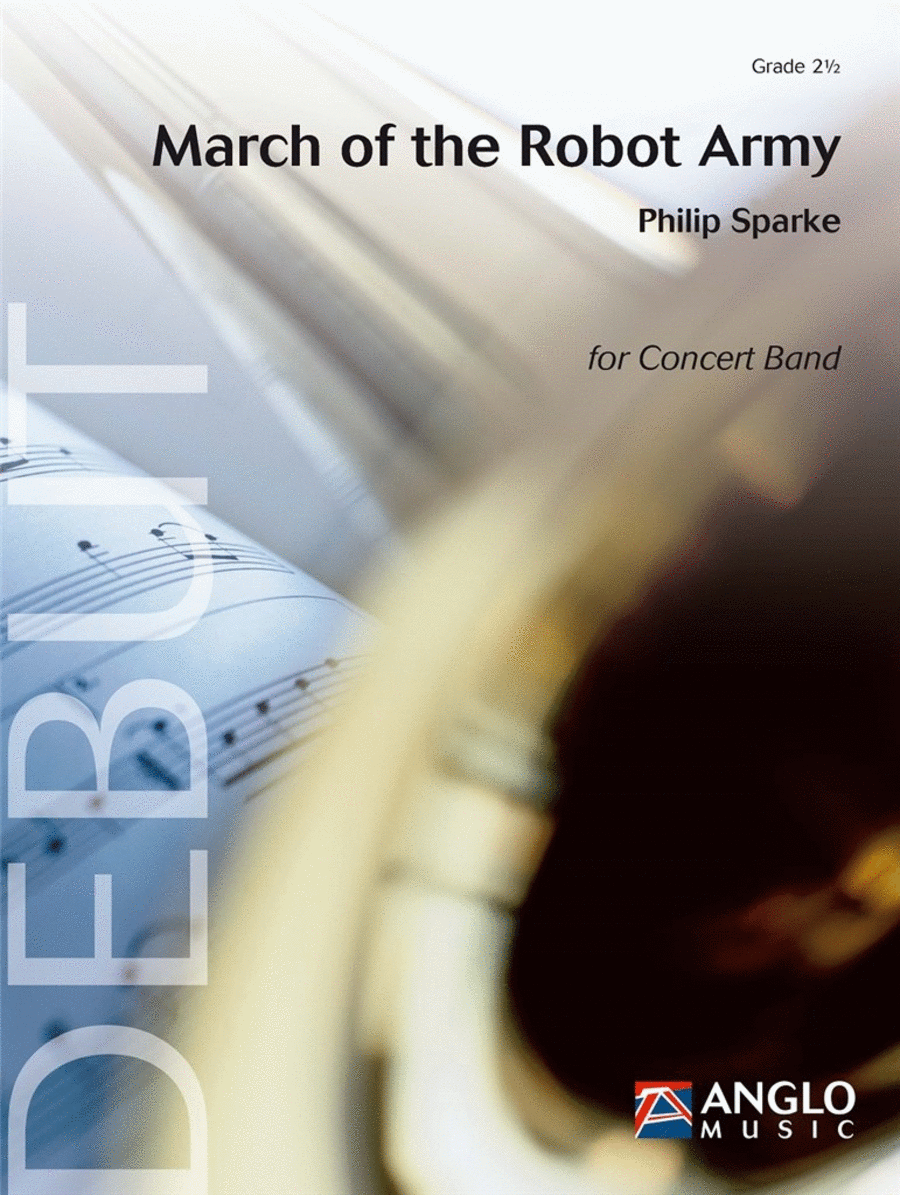Concert Band/Harmonie - Grade 2.5 SKU: BT.AMP-494-140
Composed by Philip Sparke. Debut Series (Anglo). Concert March. Score Only. Composed 2021. 28 pages. Anglo Music Press #AMP 494-140. Published by Anglo Music Press (BT.AMP-494-140). English-German-French-Dutch.
March of the Robot Army was commissioned by Linda Anzolin & Giordano-Bruno Tedeschi for Campobanda 2019, with funds made available by JUST ITALIA. Campobanda is an Italian summer music camp for 8- to 18-year-olds (held inCamposilvano in 2019) which has a different theme every year. The theme for 2019 was ‘science fiction’, so composer Philip Sparke chose to write a robot march. After a quirky introduction featuring trumpet calls and chromaticfigures, the main theme appears in a minor mode on clarinet and tenor sax and is then taken up by the full band. A change of key heralds a new theme, led by the trumpet and again repeated by the full ensemble. A further change ofkey introduces a legato ‘trio’ melody over a rather robotic accompaniment: instruments are added bit by bit until a climax is reached. Small motifs from the introduction then lead back to a full recapitulation, revisiting thefirst two themes in new guises before finishing the march with a flourish.
March of the Robot Army werd geschreven in opdracht van Linda Anzolin & Giordano-Bruno Tedeschi voor Campobanda 2019: de financiering werd mogelijk gemaakt door JUST ITALIA. Campobanda is een Italiaans zomermuziekkamp vooracht- tot achttienjarigen (dat in 2019 werd gehouden in Camposilvano) met elk jaar een ander thema. Het thema voor 2019 was sciencefiction, dus besloot componist Philip Sparke een robotmars te schrijven. Na een grilligeinleiding met trompetsignalen en chromatische motieven verschijnt het hoofdthema in mineur op klarinet en tenorsax, waarna het door het hele orkest wordt overgenomen. Een verandering van toonsoort kondigt een nieuw thema aan, weeringeleid door de trompet en herhaald door het volledige ensemble. Een verdere toonsoortverandering introduceert een legato ‘triomelodie’ boven een nogal robotachtige begeleiding: er worden stapsgewijs instrumenten toegevoegd totde muziek uitmondt in een hoogtepunt. Korte figuren uit de inleiding nemen ons dan mee naar een volledige herneming, met een terugkeer naar de eerste twee thema’s in een nieuwe gedaante, waarna de mars in stijl wordt afgesloten.
Der March of the Robot Army wurde von Linda Anzolin und Giordano-Bruno Tedeschi für Campobanda 2019“ in Auftrag gegeben und finanziell von JUST ITALIA unterstützt. Das italienische Sommermusikcamp Campobanda für 8- bis18-Jährige fand 2019 in Camposilvano statt und hat jedes Jahr ein anderes Motto. 2019 lautete das Thema Science Fiction“, daher entschied sich der Komponist Philip Sparke dazu, einen Robotermarsch zu schreiben. Nach einerskurrilen Einleitung mit Trompetenrufen und chromatischen Figuren erklingt in Klarinetten und Tenorsaxophonen das Hauptthema in Moll, das dann vom gesamten Orchester aufgegriffen werd. Ein Tonartwechsel kündigt ein neues Thema an,das von der Trompete vorgestellt und anschließend vom gesamten Ensemble wiederholt wird. Ein weiterer Tonartwechsel führt zu einem melodischen, legato gespielten Trio-Abschnitt über einer roboterhaften Begleitung. Nach und nachkommen weitere Instrumente hinzu, bis der Höhepunkt erreicht ist. Kleine Motive aus der Einleitung führen dann zu einer Reprise, wobei die ersten beiden Themen in neuer Gestalt wieder aufgegriffen werden, bevor der Marsch zum Endehin noch einmal musikalisch aufblüht.
March of the Robot Army est une commande de Linda Anzolin et Giordano-Bruno Tedeschi pour Campobanda 2019, gr ce des fonds mis disposition par JUST ITALIA. Destinée aux jeunes de 8 18 ans, Campobanda est une école demusique d’été dont le thème change chaque année. Celui de l’édition 2019 étant « sciencefiction », Philip Sparke décida d’écrire une marche pour robots. Après une introduction insolite rassemblant appels de trompette et figureschromatiques, le premier thème apparaît dans un mode mineur la clarinette et au saxophone ténor avant d’être repris par l’orchestre entier. Un changement de tonalité annonce un nouveau thème, mené par la trompette et repris,encore une fois, par l’orchestre entier. Un autre changement de tonalité introduit une mélodie legato « en trio » sur un accompagnement quelque peu robotique : divers instruments s’y ajoutent progressivement pour aboutir unclimax. Des petits motifs tirés de l’introduction mènent une récapitulation complète qui reprend les deux premiers thèmes sous des formes différentes, avant de conclure la marche avec un bouquet final.






